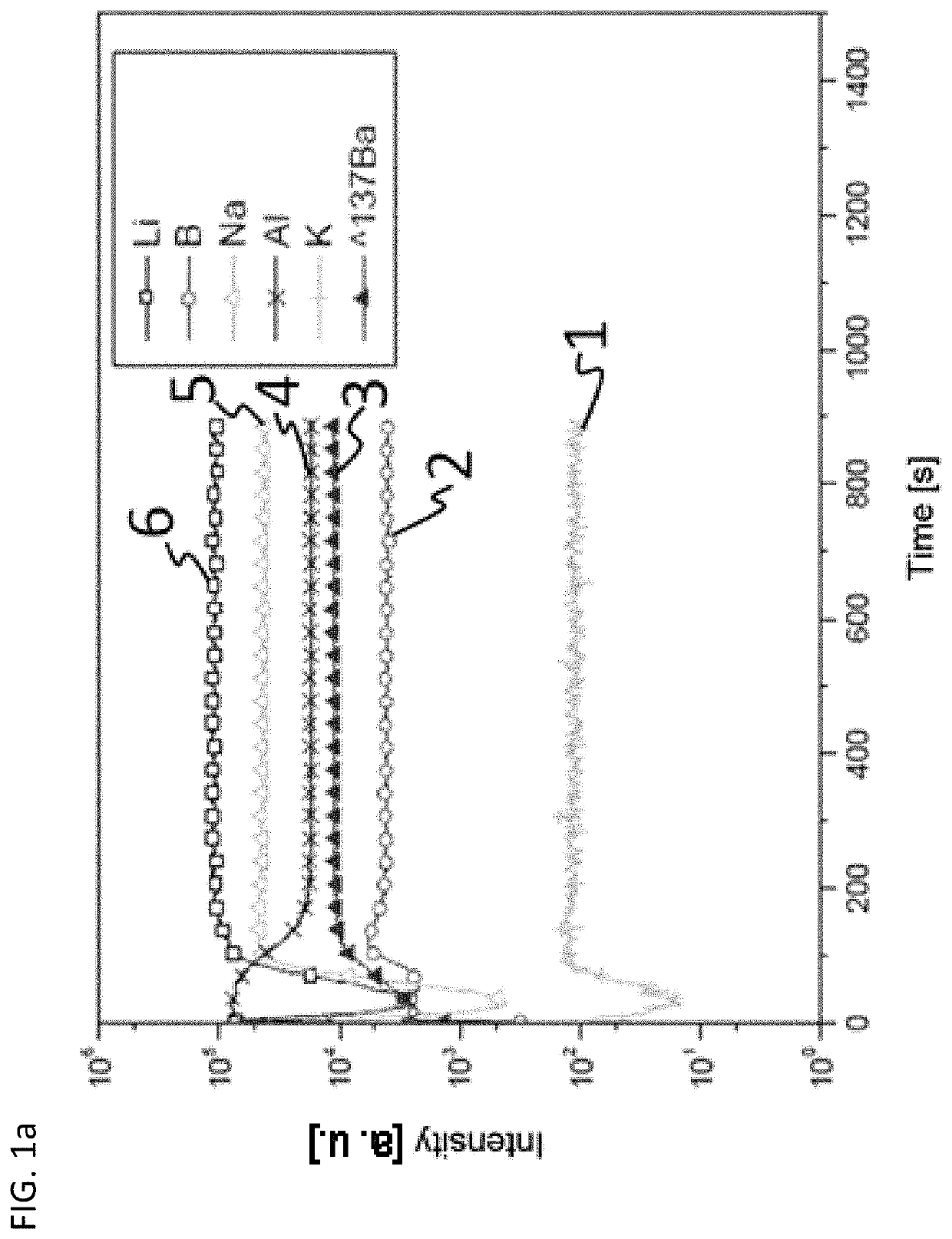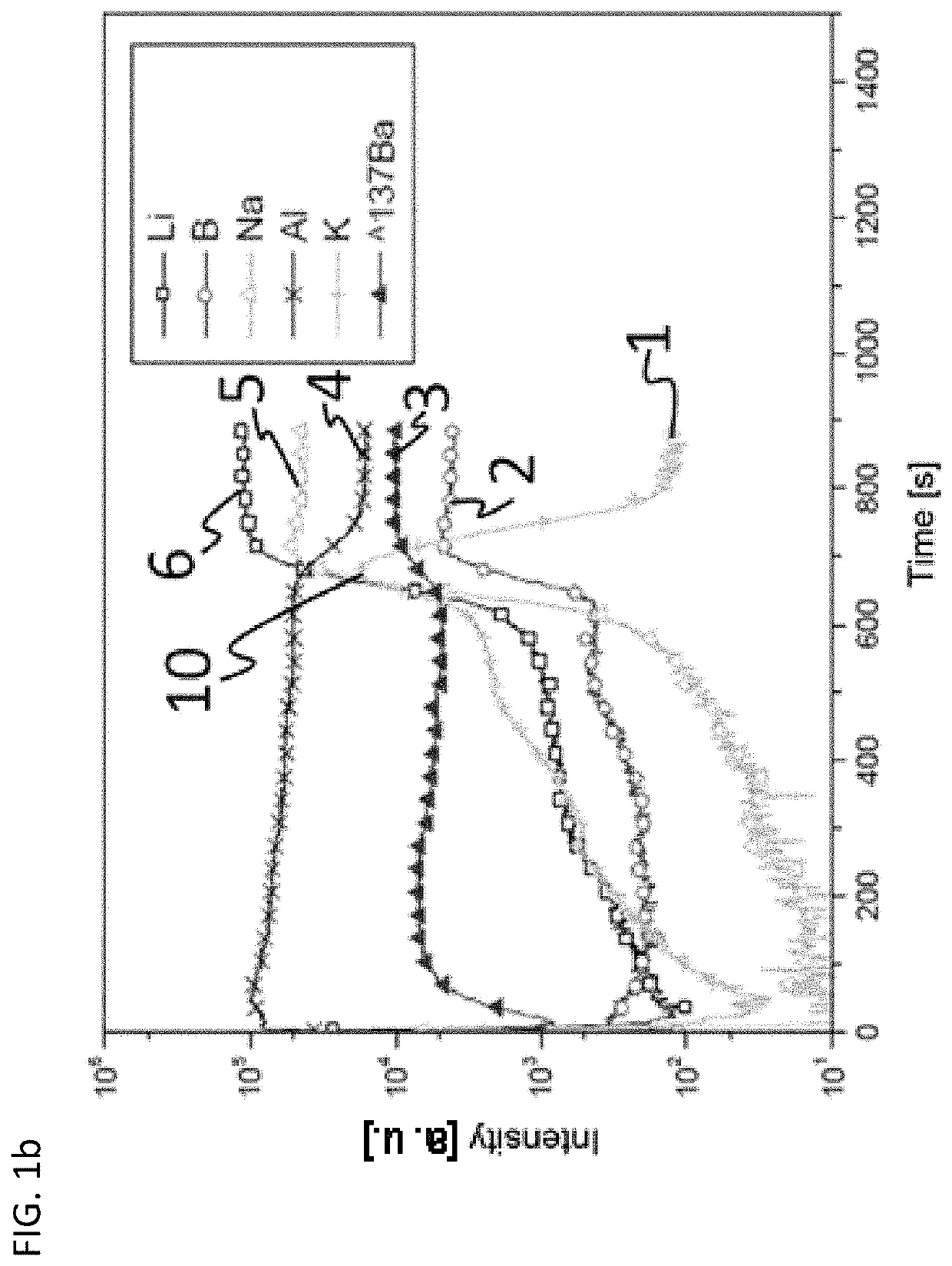Ceiling glass and use thereof
a sealing glass and glass technology, applied in the field of vitreous materials, can solve the problems of limited alkali metal oxides, known hazardous materials, and difficult stability of alkali metal oxides, and achieve the effects of increasing the density of sealing glass, low softening point, and increasing weigh
- Summary
- Abstract
- Description
- Claims
- Application Information
AI Technical Summary
Benefits of technology
Problems solved by technology
Method used
Image
Examples
example 1
[0113]In one embodiment, the sealing glass comprises the following components in % by weight on an oxide basis:
SiO255.6Al2O3 0.030B2O3 8.4Li2O 4.1K2O15.9CaO11.9ZnO 3.4F 0.54.
[0114]In the case of the composition of the sealing glass as per example 1, the following properties are achieved:
[0115]Density 2.59 g / cm3
[0116]∝20-300 10.22*10−6 / K
[0117]Softening point 601° C.
[0118]Working point 792° C.
[0119]Dielectric constant εr 7.5
[0120]Tg 470° C.
[0121]The softening point is, for the purposes of the present disclosure, the temperature at which a glass, here the sealing glass according to embodiments, has a viscosity of 107.6 dPas, and the working point is the temperature at which a glass, here the sealing glass according to embodiments, has a viscosity of 10−4 dPas.
example 2
[0122]In a further embodiment, the sealing glass comprises the following components in % by weight on an oxide basis:
SiO254.1Al2O3 0.023B2O3 9.0Li2O 4.1K2O16.6CaO11.9ZnO 3.4F 0.63.
[0123]In the case of the composition of the sealing glass as per example 2, the following properties are achieved:
[0124]Density 2.59 g / cm3
[0125]∝20-300 10.4*10−6 / K
[0126]Softening point 593° C.
[0127]Working point 777° C.
[0128]Dielectric constant εr 7.5
[0129]Tg 475° C.
example 3
[0130]In another embodiment, the sealing glass comprises the following components in % by weight on an oxide basis:
SiO253.1Al2O3 0.021B2O3 9.3Li2O 4.2K2O17.2CaO12.0ZnO 3.5F 0.68.
[0131]In the case of the composition of the sealing glass as per example 3, the following properties are achieved:
[0132]Density 2.59 g / cm3
[0133]∝20-300 10.57*10−6 / K
[0134]Softening point 588° C.
[0135]Working point 764° C.
[0136]Dielectric constant εr 7.5
[0137]Tg 470° C.
[0138]The sealing glass of examples 1 to 3 is in each case preferably free of Na2O and PbO except for unavoidable traces, where unavoidable traces of Na2O and PbO are in each case not more than 500 ppm by weight, where the sealing glass can additionally comprise secondary constituents and / or traces, for example in the form of refining agents, where the sum of the secondary constituents and / or traces is preferably less than 2% by weight in total.
[0139]Still another advantageous composition of a sealing glass according to the present disclosure...
PUM
| Property | Measurement | Unit |
|---|---|---|
| temperature | aaaaa | aaaaa |
| frequency | aaaaa | aaaaa |
| dielectric constant | aaaaa | aaaaa |
Abstract
Description
Claims
Application Information
 Login to View More
Login to View More - R&D
- Intellectual Property
- Life Sciences
- Materials
- Tech Scout
- Unparalleled Data Quality
- Higher Quality Content
- 60% Fewer Hallucinations
Browse by: Latest US Patents, China's latest patents, Technical Efficacy Thesaurus, Application Domain, Technology Topic, Popular Technical Reports.
© 2025 PatSnap. All rights reserved.Legal|Privacy policy|Modern Slavery Act Transparency Statement|Sitemap|About US| Contact US: help@patsnap.com


